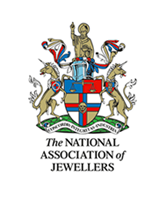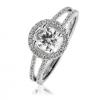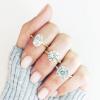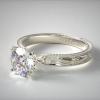Call Us On: 020 3633 3904 | Email: biggerdiamonds4less@gmail.com
Top Tips: How to Design an Engagement Ring

Choosing the ultimate engagement ring can be both an exciting and daunting experience. It goes without saying that we all want our engagement to live up to the magical moment we picture beforehand, so it is important to choose carefully when it comes to the ring itself. Sometimes you may feel that none of the rings available in-store are quite right or don’t completely meet your criteria. This is why a growing number of people decide to design an engagement ring themselves for the perfect proposal to their significant other.
The thought of designing your own engagement ring might sound scary at first, but contrary to what most people believe, it really isn’t a complicated process at all. In this article, you can find out all about our top tips and everything you need to know before you design an engagement ring.
Our Top Tips to Design Your Own Engagement Ring:
1. Start Early
The process of buying a custom ring can take anywhere from a couple of weeks to a number of months or more. Designing the dream engagement ring for your partner is one task you definitely don’t want to rush. You’ll need to allow yourself enough time to compare various custom ring makers, to revisit your design as many times as you need to perfect it, to choose the ideal gem for your engagement ring, and finally, to have the ring actually made.
2. Find Inspiration Online
Experts say that visual inspiration is very important when you design engagement rings because it helps you to picture the final product. Websites such as Pinterest and Instagram are particularly good places to look. It helps to save your favourite images by creating a mood board that you can refer back to when you decide to finally design your own engagement ring. You’ll find that you like the setting of a particular ring, the gem colour of another, and the band of something completely different. When creating your own design, it’s fine to borrow inspiration from many different places.
3. Choose Your Stone Shape
Engagement ring centre stones come in all different shapes and sizes, from the popular round cut to something more unique such as the marquise cut, princess cut and several others.
Your fiancé-to-be might already have a preferred cut which makes this step much easier because your search has already been filtered. However, if your partner hasn’t dropped any hints, you can either subtly ask for a recommendation or choose a cut that you believe will suit their taste.
Generally, the round cut is the safest option, so it’s a good choice if you’re unsure which cut is most likely to impress your future fiancé. If you’re still not sure, it’s always best to talk to a specialist that can talk you through all of the different cuts and which styles they suit.

4. The Four Cs
If you decide to keep it classy with a traditional diamond ring it’s important to understand the four Cs; carat, cut, clarity and colour. To avoid buying a diamond that just isn’t aesthetically pleasing it’s important to look at the combination of all of these factors.
- Carat: The carat is the weight of your diamond. This will not only have an impact on the appearance, but it will also have a huge impact on the price. To put it simply; the bigger the diamond, the bigger the price tag. Therefore, it’s essential that you define your budget and the carat you’re looking for before you start comparing diamonds.
- Cut: The cut of the diamond is essentially the stone’s shape. Whether you opt for round, princess, emerald, marquise, oval, pear, cushion or something else, it is important to choose a cut which suits your partner’s taste.
- Clarity: Diamond clarity is a qualitative metric that grades the appearance of each diamond based on the inclusions and blemishes on it. The fewer inclusions a diamond has the better the clarity grade. While clarity does affect the value of a diamond, most imperfections can’t be recognised by the naked eye.
- Colour: A diamond’s colour refers to how clear or yellow a diamond is. The highest quality diamonds are colourless, while lower grade diamonds often have a slight yellow tint. Diamond colour is measured using the GIA (Gemmological Institute of America) colour scale that goes from D (completely clear) to Z (light yellow or brown tint). Between the two there are numerous colour variations and grades.
5. Choose Your Metal
Traditionally, most engagement rings are made from yellow gold, white gold, silver, or platinum. However, when you design the engagement ring yourself you can select any type of metal you prefer. There are a number of materials that have grown in popularity recently including rose gold, palladium, and titanium. If you want something extra unique, you can even choose a blend of recycled metals for an environmentally friendly alternative! No matter what your preference is, it’s important to choose a metal that complements your chosen centre stone.

6. Decide on a Setting
After you’ve chosen the stone and the metal for your engagement ring, your next decision revolves around the setting. This is essentially the way your stones are arranged and will have the largest impact on what your finished ring will look like. This is why it is so important to choose a setting that compliments your choice of gemstone.
Apart from the look of your diamond or gemstone, it’s important to choose a setting that matches your fiancé’s lifestyle. Some settings are more durable while others allow more light to enter into the diamond to make it look more brilliant. Some of the popular settings include halo, channel, claw, and solitaire but there are many more available out there.
7. Find a Specialist Jeweller
For a project as important as an engagement ring, you want to find a reputable jeweller to help you bring your dream design to life. Typically, we would recommend finding a jeweller that has previously created similar rings to the one you’re looking to create. Working together with a jewellery designer whose style appeals to your aesthetical vison will ensure you end up with an engagement ring you and your partner adore.
8. Revisions, Casting and Customisation
The process to design engagement rings is a long one. After you consult with a jeweller you will be presented with a sketch or digital rendering of the ring to make sure it meets your specified criteria. Once you have approved the sketch, your designer will then make a wax model of the ring so that you can see it in 3D and get an idea of how the finished product will look. It is during this time that you can make as many revisions as necessary.
Only after that has been approved will the jeweller move forward with casting the ring. The base of the ring will be cast and cleaned first and then the stone or stones are set. Afterwards, the ring will be thoroughly polished and finalised ready for your big moment.
If you’re looking to design an engagement ring for your future husband or wife, do not hesitate to contact us! We are always on hand to answer any questions and offer advice when it comes to choosing the highest quality engagement ring for your budget.















